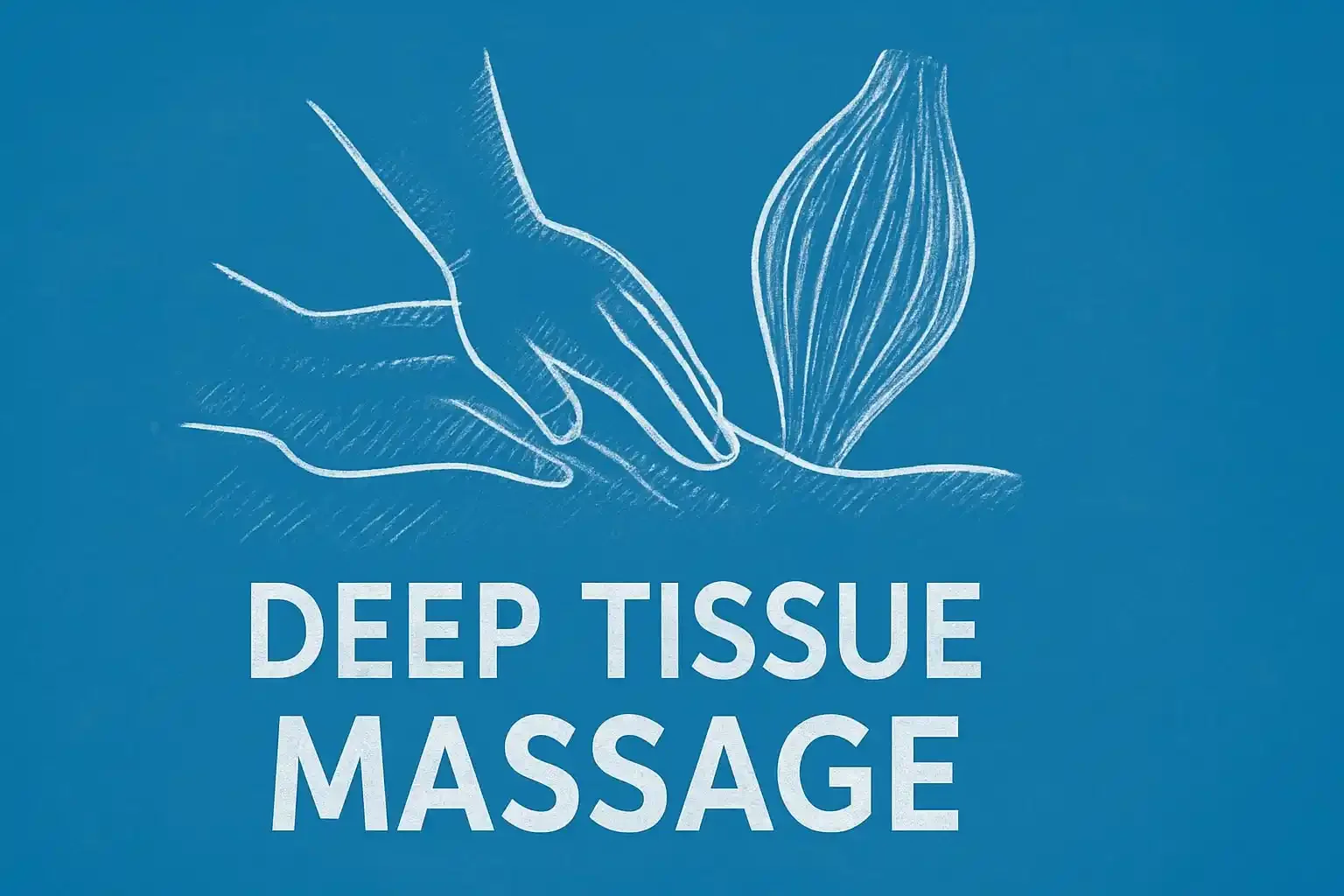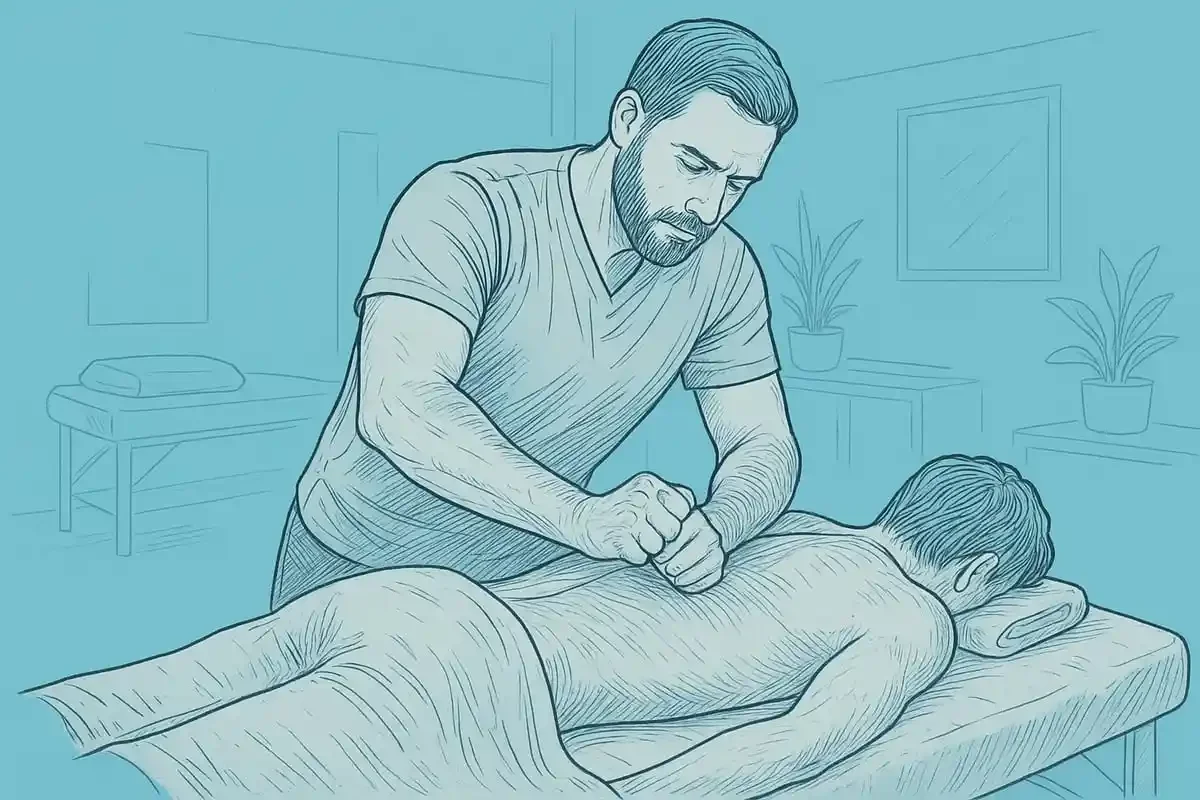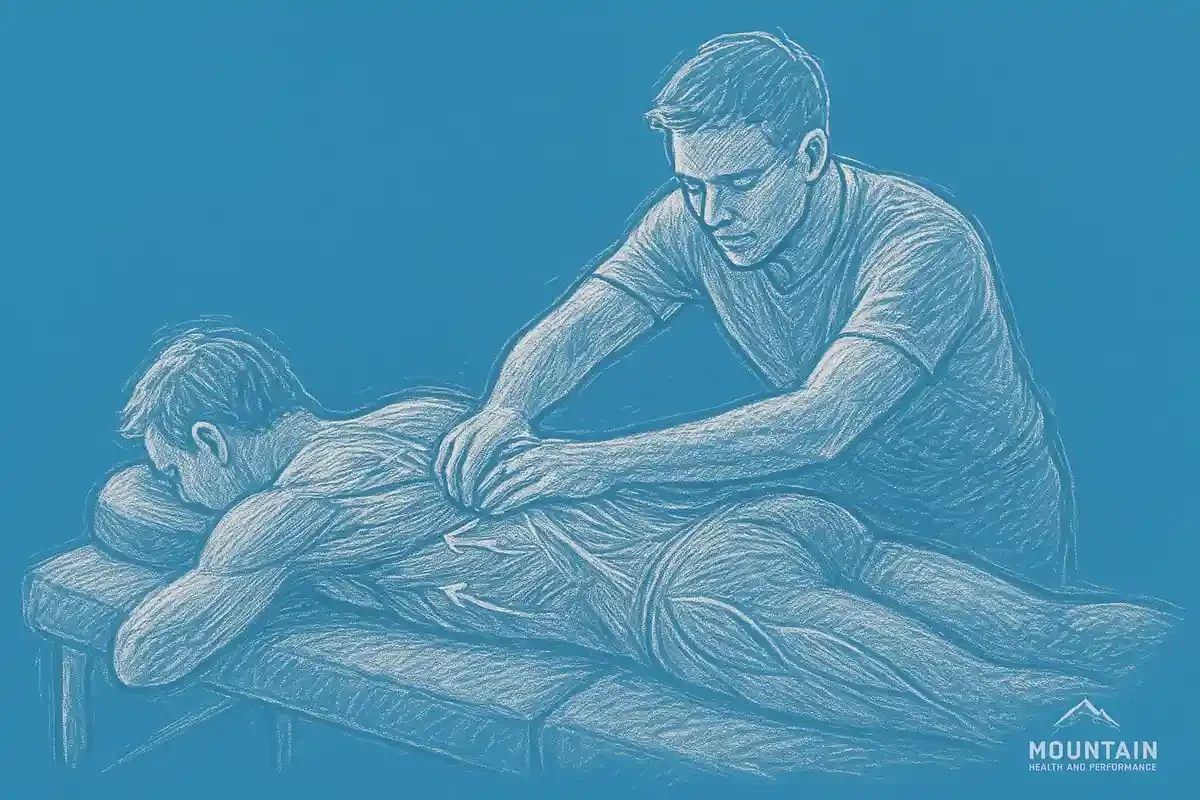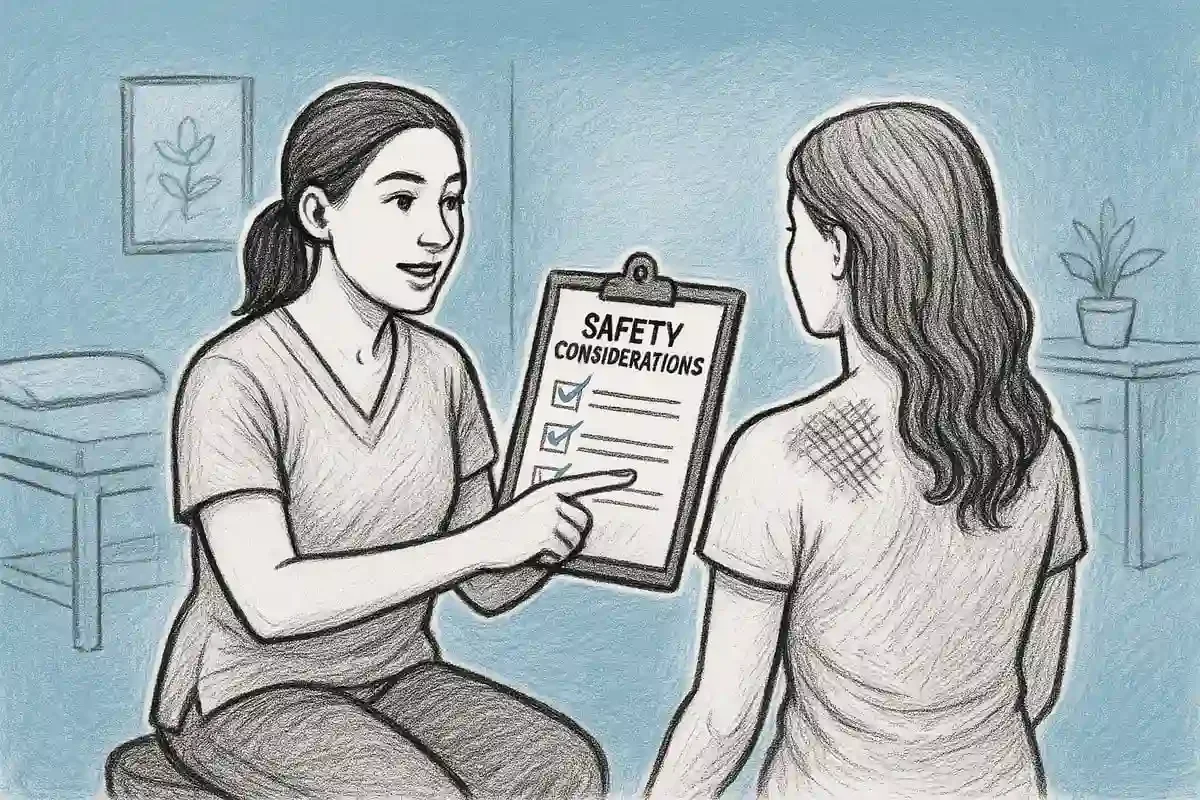Deep Tissue Massage Guide: Techniques, Benefits, and Tips 2025
Looking for lasting relief from chronic muscle pain or tension? Deep tissue massage could be the solution you need. This comprehensive guide explains what deep tissue massage is, its proven techniques, and the benefits you can expect. We’ll help you decide if it’s the right choice for your needs and share expert tips to get the best results. From the science behind the therapy to, health benefits, safety tips, and aftercare, discover everything you need to know. Learn how Mountain Health and Performance stands out for expert care and personalized treatments.
What Is Deep Tissue Massage?
If you’ve ever wondered how to address stubborn muscle pain or chronic tension, deep tissue massage could be the answer. This therapeutic approach is designed to reach beyond the surface and target the deeper layers of muscle and connective tissue, offering relief where you need it most.
Definition and Core Principles
Deep tissue massage is a specialized technique that goes beyond relaxation, focusing on real therapeutic change. By applying slow, firm pressure and deep strokes, therapists work on the deeper muscle structures and fascia to break down adhesions and scar tissue. This method is particularly effective for persistent tension, postural issues, and injuries that limit mobility.
Unlike gentle Swedish massage, deep tissue massage aims to treat underlying musculoskeletal problems, not just surface-level discomfort. It works by physically manipulating knots and chronic tightness, often using the therapist’s fingers, thumbs, or elbows to reach trouble spots.
The science behind deep tissue massage is compelling. Research, such as a 2014 study, found that deep tissue massage can reduce chronic low back pain as effectively as NSAIDs, but without medication side effects. The technique increases blood flow, reduces inflammation, and accelerates tissue repair. Many clients notice sensations like firm pressure or mild discomfort, which is normal, though pain should always be communicated.
Common issues treated include:
Chronic pain (back, neck, shoulders)
Sports injuries
Limited range of motion
Repetitive strain injuries
Deep tissue massage is especially beneficial for athletes, desk workers, and those recovering from injuries. For a deeper dive into the scientific basis and benefits, see this science-backed approach to pain relief and muscle recovery.
At Mountain Health and Performance, experienced therapists use evidence-based deep tissue massage to address musculoskeletal concerns, ensuring each session is tailored to your needs.
How Deep Tissue Massage Differs from Other Massage Types
What sets deep tissue massage apart from other modalities? The answer lies in both technique and intent. While Swedish massage uses light to moderate pressure and long, flowing strokes for relaxation, deep tissue massage employs slow, targeted movements and much greater force. The goal is not just to soothe, but to resolve chronic muscle issues at their source.
For example, if you suffer from sciatica, deep tissue massage may focus on releasing tension in the lower back and hips, helping to relieve nerve compression. Swedish massage, on the other hand, would be better for general stress relief or improving circulation.
Other related modalities include:
Trigger point therapy, which targets specific knots
Sports massage, which often combines deep tissue techniques for athletic recovery
Myofascial release, focusing on the connective tissue layer
Each approach overlaps but remains distinct in purpose and outcome. Deep tissue massage is ideal when you need structural change, not just relaxation.
Understanding these differences helps you choose the right therapy for your needs. Mountain Health and Performance can guide you in selecting the best approach, ensuring lasting results and optimal well-being.
Deep Tissue Massage Techniques: Step-by-Step Guide
Ready to experience the full benefits of deep tissue massage? Understanding what happens before, during, and after your session helps you get the most out of every visit. This step-by-step guide breaks down everything you need to know, from preparation to core techniques and what you can expect at Mountain Health and Performance.
Preparation and Communication
Before your deep tissue massage begins, preparation is key. Start by sharing your health history, pain points, and specific concerns with your therapist. This ensures your session is safe and personalized for your unique needs.
At Mountain Health and Performance, therapists conduct thorough assessments, asking questions about injuries, chronic pain, and your daily routine. This detailed approach helps target the right muscle groups and creates a treatment plan tailored just for you.
Set clear expectations about pressure and comfort levels. Don’t hesitate to speak up if you have sensitive areas or past injuries. Open communication leads to better outcomes and a more comfortable deep tissue massage experience.
Proper preparation can make a world of difference. Wear comfortable clothing, arrive a few minutes early, and remember that your input shapes the session. The more you share, the more effective your deep tissue massage will be.
Core Techniques Explained
During a deep tissue massage, therapists use slow, sustained pressure to reach deeper muscle layers and connective tissues. Expect techniques like cross-fiber friction, which breaks down adhesions and scar tissue by moving across muscle fibers. Stripping involves gliding pressure along the length of the muscle, helping to lengthen and release chronic tension.
Trigger point therapy is also common, focusing on releasing tight “knots” that refer pain to other areas. Myofascial release addresses restrictions in the fascia, the connective tissue surrounding muscles. For more detail on this technique, see Myofascial release techniques explained.
Therapists use their fingers, thumbs, elbows, and even forearms to apply precise pressure. Each technique has a specific goal, from easing chronic pain to improving mobility. For example, chronic neck and shoulder tension often responds well to a combination of stripping and trigger point work.
What to Expect During Your Session
A typical deep tissue massage session follows a structured flow. It starts with a gentle warm-up to relax superficial muscles and prepare your body for deeper work. Next comes the focused deep tissue massage, where therapists address your main areas of concern, often the back, neck, shoulders, or legs.
Client comfort is always a priority. Therapists use draping to ensure privacy and will check in about pressure throughout the session. If anything feels too intense, let your therapist know immediately so they can adjust.
After your deep tissue massage, it’s normal to feel some soreness or fatigue. Hydrating well and using heat or ice packs can help ease discomfort. Most clients leave feeling looser, more relaxed, and with a noticeable reduction in pain and tension.
Deep Tissue Massage at Mountain Health and Performance
Mountain Health and Performance is a trusted leader in deep tissue massage. With over 35 years of experience in musculoskeletal health and sports injury rehabilitation, their registered massage therapists deliver evidence-based, personalized care.
Every deep tissue massage session at Mountain Health and Performance integrates thorough assessments, advanced techniques, and ongoing communication. Their integrated approach combines chiropractic, massage, and rehabilitation for optimal results, making them a top choice for athletes, office workers, and anyone recovering from injury.
Conveniently located in North Vancouver, the clinic offers direct billing, weekend appointments, and specialized support for ICBC and WorkSafe BC claims. Booking a deep tissue massage is simple. Just call or visit their website to schedule your session and start your journey to lasting relief.
Mountain Health and Performance stands out for its commitment to client outcomes, clinical expertise, and welcoming environment. Experience the difference a tailored deep tissue massage can make in your health and wellness journey.
Health Benefits of Deep Tissue Massage
Looking for ways to ease stubborn aches, improve mobility, or recover from injuries? Deep tissue massage offers a powerful solution for those seeking real, lasting results. This section explores the key physical and psychological benefits, supported by research and real-world stories from clients at Mountain Health and Performance.
Physical Benefits
Deep tissue massage is known for its remarkable ability to relieve chronic pain and muscle tension. By targeting the deeper layers of muscle and connective tissue, this therapy can address stubborn issues like back pain, neck stiffness, and sciatica. Many clients at Mountain Health and Performance find deep tissue massage especially helpful for managing long-term discomfort from conditions such as fibromyalgia and repetitive strain injuries.
One of the core physical benefits is improved mobility and flexibility. When muscles are tight or knotted, movement can feel restricted. Deep tissue massage helps to release adhesions and scar tissue, restoring natural range of motion. This is particularly valuable for athletes, office workers, and anyone recovering from injuries.
Enhanced circulation is another key advantage. By increasing blood flow to affected areas, deep tissue massage supports the delivery of oxygen and nutrients needed for healing. This boost in circulation helps reduce inflammation and speeds up recovery from sports injuries, whiplash, or overuse.
Here’s a summary of the most common physical benefits:
Benefit / Description
Pain relief / Eases chronic back, neck, and joint pain
Improved mobility / Increases flexibility and range of motion
Injury recovery / Accelerates healing from strains and sprains
Scar tissue breakdown / Reduces adhesions for long-term relief
Enhanced circulation / Promotes tissue repair and reduces inflammation
Clients at Mountain Health and Performance often report feeling lighter and more comfortable in their bodies after just a few sessions of deep tissue massage. For many, this therapy is a cornerstone of their ongoing wellness routine.
Psychological and Wellness Benefits
Beyond physical relief, deep tissue massage offers substantial psychological benefits. Stress is a common trigger for muscle tension, and regular sessions can help lower cortisol levels, the hormone responsible for stress. As tension melts away, many people experience a sense of deep relaxation and mental clarity.
Improved sleep quality is another significant outcome. Deep tissue massage helps calm the nervous system, making it easier to fall and stay asleep. For those dealing with anxiety or high-pressure work environments, this therapy can provide a welcome sense of balance and calm.
Clients often share stories of transformation after deep tissue massage at Mountain Health and Performance. Athletes describe feeling more focused and resilient, while office workers report less pain from poor posture and long hours at a desk. Chronic pain sufferers find that regular treatment helps them regain control over their daily lives.
Some common wellness benefits include:
Reduced anxiety and mental fatigue
Enhanced mood and increased endorphin levels
Better sleep patterns and higher energy
Greater sense of well-being and self-care
Real-world testimonials highlight these outcomes. One client shared, “After just a few sessions at Mountain Health and Performance, my back pain improved and I started sleeping through the night again.” Another noted, “Deep tissue massage has become my go-to for stress relief and injury prevention.”
Deep tissue massage is more than just a physical therapy; it’s a holistic approach to wellness that supports both body and mind.
Supporting Data and Research
The benefits of deep tissue massage are backed by a growing body of scientific research. A 2014 study found that deep tissue massage provided significant pain relief for chronic low back pain, with results comparable to common medications like NSAIDs. Another study from 2008 reported positive effects on blood pressure and heart rate, demonstrating its impact on overall health.
Leading health organizations continue to recognize the value of massage therapy for a range of conditions. For example, the Massage Therapy for Health: What the Science Says resource from the National Institutes of Health summarizes the latest findings on pain relief, recovery, and psychological well-being.
Mountain Health and Performance stays up to date with these advancements, ensuring their clients receive evidence-based care. Their registered massage therapists integrate current research into every session, personalizing treatments for optimal results.
If you’re seeking a proven, science-backed approach to pain management and wellness, deep tissue massage at Mountain Health and Performance is a smart choice. Evidence shows that regular sessions can make a real difference for chronic pain, mobility, and overall quality of life.
Safety, Contraindications, and Side Effects
Staying safe during a deep tissue massage is essential for the best results. Knowing when this technique is right for you, understanding possible side effects, and choosing a qualified therapist will help you get the most from your session.
Who Should and Shouldn’t Get Deep Tissue Massage
Not everyone is a good candidate for deep tissue massage. While this therapy can help many people, certain health issues make it unsafe. If you have blood clotting disorders, recent surgery, severe osteoporosis, open wounds, or skin infections, it is best to avoid deep tissue massage until cleared by a doctor.
Pregnancy and cancer are also times when extra caution is needed. Always consult your healthcare provider if you have chronic health conditions or are on blood thinners. Sometimes, a gentler option like Swedish massage is safer, especially for older adults or those with fragile health.
If you are unsure, speak with your therapist before booking. At Mountain Health and Performance, therapists always review your health history and advise you if deep tissue massage is appropriate.
Potential Side Effects and How to Manage Them
Most people experience some mild side effects after deep tissue massage. Common reactions include soreness, mild bruising, or temporary fatigue. These effects are usually short-lived and part of the body’s natural healing process.
To minimize discomfort, drink plenty of water after your session, rest as needed, and use heat or cold packs for any sore spots. If you notice severe pain, swelling, or symptoms that do not improve, contact your healthcare provider right away.
Listening to your body is key. Your therapist can also suggest ways to manage aftereffects, so do not hesitate to ask for advice during your visit.
Therapist Qualifications and Client Safety
Choosing a skilled, registered therapist is the most important step in ensuring your deep tissue massage is safe and effective. Look for licensed registered massage therapists (RMTs) with experience in musculoskeletal health and injury recovery.
At Mountain Health and Performance, all therapists are highly trained and use evidence-based approaches for every deep tissue massage session. Sessions are tailored to your needs, with constant communication to adjust pressure and focus areas.
Working with a registered professional not only ensures better results, but also adds a layer of safety. For more on why this matters, see the Benefits of registered massage therapy.
Remember, you have the right to speak up about comfort, pressure, and consent at any time. Your well-being is always the top priority.
How to Find the Right Deep Tissue Massage Therapist in 2025
Finding the right deep tissue massage therapist can make all the difference in your results. The process goes beyond a quick online search. You want a therapist who has the right credentials, experience, and a patient-focused approach. Whether you are recovering from an injury, dealing with chronic tension, or simply seeking better mobility, taking the time to choose a qualified provider is essential.
Credentials and Experience to Look For
Start by verifying that your deep tissue massage therapist is a Registered Massage Therapist (RMT) with up-to-date licensing in your region. An RMT designation ensures advanced training in anatomy, physiology, and therapeutic techniques. Look for therapists who specialize in deep tissue massage and have experience treating musculoskeletal conditions.
Continuing education is also a good sign, as it shows your therapist stays current with the latest methods. Ask about their experience with your specific needs, such as sports injuries or chronic pain. This helps you feel confident that your deep tissue massage will be safe and effective.
Where to Search and What to Ask
Use professional associations and online directories to find reputable clinics in your area. Reading reviews and testimonials can offer insight into the therapist’s reputation and approach. Before booking, ask about their experience with your health concerns, clinic amenities, and billing options.
For more tips on selecting a qualified RMT, visit the Finding a registered massage therapist guide. This resource covers key questions to ask and how to verify credentials, so you can make an informed choice for your deep tissue massage sessions.
Example: Choosing Mountain Health and Performance
Mountain Health and Performance stands out as a leader in deep tissue massage. Their team brings over 35 years of clinical experience in musculoskeletal health and sports injury rehab. Patients benefit from an integrated approach, combining massage, chiropractic care, and rehabilitation for optimal results.
The clinic makes deep tissue massage accessible with direct insurance billing, weekend appointments, and specialized care for ICBC and WorkSafe BC claims. Their patient-centered model ensures your sessions are tailored to your unique needs, with clear communication and flexible scheduling.
Cost, Insurance, and Accessibility
Deep tissue massage pricing in 2025 varies by region and session length. Expect a typical range between $110 and $140 per session. Many clinics, including Mountain Health and Performance, offer direct billing to major insurers, which can save you time and hassle.
When choosing a clinic, consider location, parking, and transit options to ensure easy access. Ask about insurance coverage, especially if you need support for injury recovery. By prioritizing these factors, you can enjoy consistent deep tissue massage care that fits your lifestyle and budget.
Expert Tips for Maximizing Your Deep Tissue Massage Results
Looking to get the most out of your deep tissue massage? Whether you are new to this technique or a seasoned client, a few expert strategies can help you maximize results and recovery.
Before Your Appointment
Preparation sets the stage for a successful deep tissue massage. Start by hydrating with water throughout the day to keep muscles supple. Arrive a few minutes early so you have time to discuss your health history and any pain points with your therapist.
Wear comfortable clothing that is easy to change out of. Avoid heavy meals right before your appointment. Set clear goals and let your therapist know what you hope to achieve, whether it is pain relief, improved flexibility, or recovery from injury.
A reputable clinic like Mountain Health and Performance will always prioritize this initial conversation, ensuring your deep tissue massage session is tailored to your needs.
During the Massage
Open communication during your deep tissue massage is essential. Speak up if the pressure feels too intense or if you experience sharp pain. Your comfort should always be the priority.
Focus on your breathing and try to relax each muscle group as the therapist works. Mild discomfort is normal as tight muscles release, but you should never feel unsafe or overwhelmed.
Experienced therapists, such as those at Mountain Health and Performance, check in with you throughout the session and adjust techniques for your comfort. Remember, feedback helps your therapist deliver the best possible results.
Aftercare and Recovery
Proper aftercare supports the benefits of your deep tissue massage. Drink extra water post-session to help flush out metabolic waste and reduce muscle soreness. Apply a warm compress or take a gentle walk to encourage circulation.
If you feel sore, light stretching or a cool pack can ease discomfort. Rest is just as important as movement, so listen to your body and take it easy for the rest of the day. For more on how registered massage therapy can support your recovery, see the Benefits of registered massage therapy.
Long-Term Strategies
Consistency is key for lasting benefits from deep tissue massage. Schedule regular appointments if you are managing chronic pain or recovering from an injury. Combining massage with other therapies, such as physiotherapy or chiropractic care, can further enhance your progress.
Track your results and communicate any changes in symptoms with your therapist. Many athletes and office workers at Mountain Health and Performance have shared success stories of reduced pain and improved performance through a holistic approach.
With the right plan and support from experienced therapists, deep tissue massage can be a transformative part of your wellness routine.
Frequently Asked Questions About Deep Tissue Massage
Curious about deep tissue massage and how it can help you? Here are the most common questions answered to help you get the most from your experience.
How often should I get a deep tissue massage?
The ideal frequency depends on your goals and lifestyle. For chronic pain or injury recovery, weekly or bi-weekly sessions are common. If you want to maintain muscle health or manage stress, a session every three to four weeks may be enough. Mountain Health and Performance therapists can recommend a schedule based on your needs.
Does deep tissue massage hurt? How much discomfort is normal?
You might feel some discomfort during deep tissue massage, especially when the therapist works on tense areas. However, the pressure should never cause sharp pain. Always communicate your comfort level during the session. Soreness for a day or two afterward is normal and usually resolves quickly.
What should I do if I feel sore after a session?
Soreness is common after a deep tissue massage, especially if you are new to this technique. Drink plenty of water, rest, and use a warm compress or gentle stretching to ease muscle tension. If soreness persists or worsens, consult your therapist for advice.
Can deep tissue massage help with specific conditions like sciatica or fibromyalgia?
Yes, deep tissue massage is often used to manage chronic conditions such as sciatica, fibromyalgia, and low back pain. Research supports its effectiveness for many pain conditions.
Is it safe during pregnancy or for older adults?
Deep tissue massage is not usually recommended during pregnancy, especially during the first trimester or if there are complications. Older adults should always discuss health history with their therapist. In some cases, a gentler technique may be safer.
How do I prepare for my first session?
Arrive early to fill out any forms and discuss your health history with your therapist. Wear comfortable clothing, hydrate, and avoid heavy meals beforehand. Setting clear goals will help your therapist tailor the session for you.
What makes deep tissue massage different from other therapies?
Deep tissue massage uses more pressure and slower strokes than Swedish massage, targeting deeper layers of muscle and connective tissue.
Can I combine deep tissue massage with other treatments?
Absolutely. Many clients at Mountain Health and Performance combine deep tissue massage with chiropractic care, physiotherapy, or exercise for optimal results. Always inform your therapists about other treatments you are receiving so they can coordinate care.
Whether you are seeking pain relief, improved mobility, or stress reduction, deep tissue massage can be a valuable part of your wellness routine. For expert care and a personalized approach, Mountain Health and Performance is ready to help.
Now that you know what it's all about, from the science and techniques to the real health benefits and expert tips, you might be wondering how to put this knowledge into action. If you’re ready to experience lasting relief from muscle tension or want to boost your recovery with the support of a skilled professional, you don’t have to figure it out alone. The team at Mountain Health and Performance has helped countless people just like you feel their best. Why not take the next step and Book with one of our massage therapists today?




